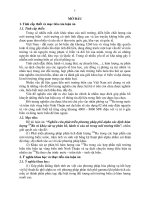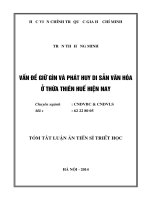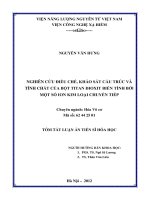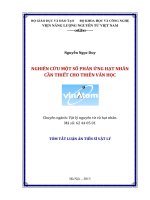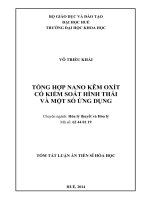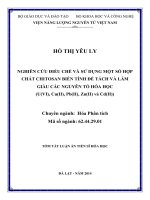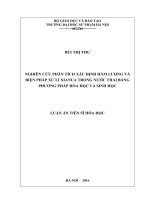(Tóm tắt Luận án tiến sĩ Hóa học bằng tiếng anh) NGHIÊN CỨU PHÂN TÍCH XÁC ĐỊNH HÀM LƯỢNG VÀ BIỆN PHÁP XỬ LÍ XIANUA TRONG NƯỚC THẢI BẰNG PHƯƠNG PHÁP HÓA HỌC VÀ SINH HỌC
Bạn đang xem bản rút gọn của tài liệu. Xem và tải ngay bản đầy đủ của tài liệu tại đây (589.16 KB, 12 trang )
24
1
2. Have assessed the ability to decompound the stable cyanides complex
(take 2 iron complexes of the [Fe (CN) 6]4- and [Fe (CN) 6] 3- represented)
with cyanide distillation system in acidic medium.
- Performance of decomposition to 84 ÷ 100%.
- The average recovery of the complex on range of 90÷ 100% consistent
with the provisions of AOAC.
3. By applying the method to analyze 1320 wastewater samples at 44
locations in 4 districts of Hanoi and 180 wastewater samples at 6 position
of 2 gold mining places in Thai Nguyen province in both rainy and dry
seasons. The obtained results showed that:
• For metal plating waste water in Hanoi:
- The average cyanide content of 04 districts are relatively high (~ 2,150
mg/L), excess of criteria B 40: 2011 / BTNMT about 20 times, of which
52.3% of the samples exceeded the wastewater QCVN industry.
- The average concentration of cyanide in water samples in dry season
higher than in the wet season about 21.2%, and cyanide in a some
samples are negligible
• For waste water of gold mining dumps in Thai Nguyen:
- The average content of cyanide in waste water of 02 of gold mining
dumps is relatively high (0.571 mg/L). Compared to the B of criteria 40:
2011/BTNMT exceed 5.3 times, which has 88.9% of the samples exceed
QCVN 40: 2011/BTNMT. If compared with the Criteria B, QCVN 08:
2008/BTNMT exceed 28.5 times.
- The average concentration of cyanide in water samples dry season
higher than the wet season about 10%.
Thus, cyanide contamination levels are very serious.
4. Has the study of factors affecting the oxidation of cyanide in waste
water treatment metalized by agent Na2S2O5 / Cu2+ at laboratory scale.
Results of wastewater treatment facility in a number of villages in metal
plating Thanh Thuy and galvanizing facility Hai Boi commune, Dong
Anh District, Hanoi have reached 98.52% and Performance 99.43%.
5. Along with chemical methods, has researched cyanide in waste water
treatment galvanized metal, water hyacinth, results showed:
- Just 1kg of hyacinth after 28 days, the treated effluent is 36 liters (0.190
mgCN- concentration/L) standard level of criteria B, QCVN 08: 2008
/BTNMT.
- The average age hyacinth better handle young hyacinth.
INTRODUCTION
1.The urgency of the subject
In our country the problem of pollution of water sources in many
places are at an alarming rate, especially in the big cities and industrial
zones. Speed of industrialization and urbanization was accelerated with
the increase of population by waste sources, has caused increasingly
heavy pressure on social and community. In wastewater, wastewater
containing cyanide group is particularly interested because of its toxicity,
because cyanide is classified as hazardous waste. Acid HCN and its salts
are very strong poison, with just 50 mg it can kill a person. However, the
cyanide salts were used extensively in industries such as industrial
plating (gold, silver, copper, zinc ...), gold mining industry, industry
manufacturing pigments (pigment) used for paint, powder paint, and
textile dyeing. Beside, cyanide salts were as raw materials manufacturing
pesticide as calcium cyanide to kill bed bugs and insects in housing. Now
there are many methods of cyanide analysis such as ion chromatography,
capillary electrophoresis chromatography, electrochemistry However,
these methods are highly sensitive, high accuracy, but must use
equipments expensive and often only equipped in laboratories at large.
Spectrophotometric method requires only a simple optical measuring
machine and inexpensive reagents. Spectrophotometric method UV-Vis
based on pyridine - pyrazolone or pyridine - barbituric reagents
determining cyanide were suggested by the authors but not being studied
in detail.
Therefore, the theme "Research and analysis to determine the
amount and treatment of cyanide in wastewater by chemical methods and
biological" was chosen to be our doctorial dissertation title.
2. The aim of the thesis
• Developing method to determine cyanide:
The thesis was focused on building spectrophotometric method UV-Vis to
analyze the concentration of cyanide in the water, using reagents: pyridine pyrazolone and pyridine - barbituric. On that basis, by comparing, evaluating
between them, the appropriate method will be selected.
• Determination of cyanide in water samples:
Applying the method developed, determining the concentrations of
cyanide in waste water samples of the metal plating places (in 04 districts
of Hanoi such as in Thanh Tri, Phuc Tho, Thanh Oai and Dong Anh
Eastern) and water samples from gold mining waste (in 02 gold mining
places as Ngan Me and My Hoa Dong Hy district, Thai Nguyen
2
province). From the data obtained, allowing an overall rating cyanide
pollution levels in these areas.
• Studying two cyanide processing methods in laboratory scale: chemical
method: using oxidizing agent Na2S2O5 combined catalyst Cu2+;
Biological methods: using water hyacinth plants.
3. Research Content
- Investigation of optimal conditions and building spectrophotometric
calibration curve to determine the amount of cyanide using pyridine pyrazolone and reagents pyridine – barbituric reagents
- Assess the efficiency of cyanide conversion in stable complexes with
the distillation system dedicated cyanide.
- Sampling and analysis systematically cyanide concentration in the
wastewater samples. Based on the analytical results in 03 years (20132015) in both dry and rainy seasons, a comprehensive assessment of
cyanide pollution levels in these localities was implemented.
Research and select oxidizing agent sodium metabisulfite combined
catalyst ( Na2S2O5 and Cu2+) and hyacinth plants to handle cyanide in
some typical water samples at laboratory scale.
4. The contributions of the thesis
- Systematically study to find the optimal conditions for the reaction of
cyanide compoundation with 2 color reagents: pyridine - pyrazolone and
pyridine – barbituric was implemented. The optimal absorption of the
cyanide compounds with reagents and the standard curve with high accuracy
to determine cyanide have been established.
- A comprehensive study to confirm the value of use of the method such as
the limit of detection, LOD, LOQ limit of quantification, repeatability,
precision, thereby confirming the reliability of the method.
- Detailed analysis results in 3 years (2013-2015) being a dataset allows a
comprehensive assessment of the current state of cyanide in waste water
pollution in metal plating in 4 districts of Hanoi (in 44 locations, 1320
samples /3 years) and in wastewater of 2 places of gold mining in Thai
Nguyen (in 6 positions, 180 samples /3 years). The results showed that the
cyanide pollution in the locality is very serious.
- Used Na2S2O5 combined catalyst of Cu2+ and hyacinth plants to handle cyanide
in the waste water are the methods having high processing performance.
6. The layout of the thesis
The thesis consists of 145 pages, with 63 tables and 52 figures, the structure
consists of: Introduction 04 pages; Chapter 1: Overview 36 pages; Chapter
2: Experimental 31 pages; Chapter 3: Results and discussion 65 pages;
Conclusion 02 pages; The list of works of authors related to the thesis 01
pages; Reference page 06.
23
Figure 3.34. The results determining the amount of cyanide in hyacinth
samples and control sample feed (control)
From the results on the Table 3.45 and figure 3.34 it shows:
After 21 days treatment, the concentration of cyanide reached
criteria B of QCVN 40: 2011/BTNMT limits when discharging industrial
effluents into water sources used for drinking water supply. After 28 days
treatment, the concentration of cyanide reached criteria B of QCVN 08:
2008/BTNMT limits when discharging industrial effluents into water
sources used for drinking water supply. This show that: both young and
average age hyacinth are capable of processing handling cyanide, but at
average age hyacinth has longer roots, grow stronger and processing
capabilities better handle young hyacinth.
CONCLUSION
1.Have examined the optimal conditions and building spectrophotometric
calibration curve to determine the amount of cyanide used pyridine –
pyrazolone and reagents pyridine - barbutiric. On that basis photometric
selection method with reagents pyridine-barbituric reagents to determine
the amount of cyanide in the water sample.
- Calibration is built under the optimal conditions: λmax = 580 with molar
ratio nChloramine T / nCN = 2.2x10-5 / 1,9x10-7 ~ 115; V(TT2)/VCN = 3 / 2.5;
time = 30 minutes. Calibration curve equation is as follows
A = (2.511 ± 0.072).CCN- + (0.018 ± 0.009)
The correlation coefficient R2 = 0.9985. Linear in the range: 0.01 ÷ 0.30 mg/L
- Limit of Detection: LOD = 3,6.10-3 (mg / L) = 3.6 ppb
- Limit of quatification: LOQ = 0.012 (mg /L) = 12 ppb
22
3
From the results on the board 3.43 shows:
• Recycle 1 (CCN- = 1.900 mg/L): until to 2nd day appears hyacinth
phenomenon dirt poor, weakened trees. From day 3th hyacinth starts
wilting and dying. Thus dirt inappropriate in CCN- = 1.90 mg/L.
• Containers 2 (CCN- = 0.380 mg/L - diluted 5 times the bucket 1):
hyacinth not wither, but grow slowly. After the 7th day phenomenon
appears dirt poor hyacinth, weakened hyacinth. From 9th hyacinth starts
wilting and death, concentration dropped 0.257 CN mgCN-/L. After 10
days, we stopped feeding hyacinth.
• Containers 3 (CCN- = 0.190 mg/L - diluted 10 times with box 1):
hyacinth grows well, not bad and withered leaves phenomenon. CN
concentrations in animal form tapered. By day 14 was 0.104 mg CN/L.
Therefore we determined the concentration of CN cease after 14 days.
Summary: initial concentration CN huge impact on the growth and
development of the hyacinth. We found hyacinth likely grows and
develops normally at low cyanide concentration of (CCN = 0.190 mg/L).
3.5.2.3. Results of treatment of plating wastewater samples at Thuy
Thanh village, Thanh Oai District, Hanoi
Results of cyanide treatment in waste water in the village of
Thanh Thuy plated, Thanh Oai District, Hanoi by hyacinth and control
samples (control) not treated with hyacinth are presented in table 3.45
and Figure 3.34.
Table 3.45. The results determining the amount of cyanide in hyacinth
samples and control sample feed (control)
CHAPTER 1. OVERVIEW
Compared sample
(no hyacinth)
Time
(days
hyacinth
Young
(box 2)
Medium age
(box 3)
Csampl (mg/L)
H%
CCN
(mg/L)
H
(%)
CCN
(mg/L)
H (%)
0
0.190
/
0.190
/
0.190
/
7
0.190
0
0.144
24.02
0.124
34.74
14
0.188
1,05
0.118
37.63
0.102
47.37
21
0.185
2,63
0.088
53.64
0.065
65.26
28
0.180
5.26
0.052
72.63
0.020
89.47
1.1. CYANIDE AND CYANIDE COMPOUNDS
1.1.2. Origins of cyanide pollution
• Sources of cyanide in wastewater from electroplating facilities
• Sources of cyanide waste from gold mining establishments
1.3. METHOD FOR DETERMINING CYANIDE
1.3.3. Several methods for determining cyanide
• Determination of total cyanide by spectrophotometric method using
chloramine T and pyridine-pyrozalone. This approach was based on the
distillation enriched cyanide as HCN gas, then absorbed in an alkaline
solution. The content of cyanide (CN- ) was determined by spectrophotometric
method using pyridine-barbituric reagent after CN- was chlorinated by
chloramine T created ClCN, then CN- content was determined by the color
compound with pyridine-pyrozalone reagent, using standard curve. Methods
for determination of cyanide is conducted in 3 steps:
-Step 1. Distillation, cyanide enrichment. Reactor containing strong acids
such as H2SO4, here all forms of cyanide complexes including durable
form are breaking HCN gas released:
The all types of cyanide + H2SO4 → HCN + SO42- + other products (1.23)
- Step 2. Create compound chlorcianide ClCN
HCL gas is adsorbed in alkaline forming reaction with chloramine-T:
CN- +
+H2O → ClCN +
(1.24)
- Step 3. Formation of color compound
Products formed clan reacted with pyridine-pyrazolone reagent to
produce blue complex compound using for the determination of cyanide
in samples by its absorbance at λ= 614 nm.
• Determination of total cyanide by spectrophotometric method using
chloramine -T and pyridine-barbituric
This is a method for determining total cyanide content in water sample.
The principle method was conducted similarly to method using pyridinepyrazolone reagent. Here pyridine-barbituric reagent was used . The
obtained color compound is red.
Principle of method: cyanide ion is oxidized by chloramin -T
into cyanogen chloride CNCl at pH <8 (to not happen hydrolysis), then
chelating with pyridine - barbituric to form red compound having an
absorption maxima at 578nm wavelength. These reactions can occur
scheduled as follow:
4
- Chlorination by chloramine T
CN + Chloramines-T →
- CNCl reaction with pyridine:
ClCN
21
+
other
products
(1.25)
(1.26)
The next reaction is complexing to produce red compound:
Under this method, though some works have, but were found to
have the research necessary to obtain accurate analysis results. The study
in detail will focused on the selection of equipment, the concentration of
chemicals and reagents as well as the reaction time to obtain good
experimental results.
1.4. METHODS OF CYANAIDE TREATMENT
1.4.1. Oxidation Method
1.4.2. Electrolysis method
1.4.3. Precipitation method
1.4.4. Biological methods
wastewater, cyanide removal efficiency reached 98.61%. Model M10,
wastewater, cyanide removal efficiency reached 99.43%.
3.5.2. Results of cyanide treatment with water hyacinth processing
3.5.2.1. Results determined pH threshold of hyacinth
3.5.2.2. Determination of cyanide threshold of hyacinth
Results determined threshold of 3 barrels of cyanide in each period and
the growth of duckweed is presented in Table 3.43:
Table 3.43. Findings CN- threshold to the growth of hyacinth
Box
Initial conc,
(mgCN-/L)
1
1.900
2
0.380
(f=5)
CHAPTER 2. EXPERIMENTAL PART
2.1. TOOLS, EQUIPMENT, CHEMICALS
2.1.1. Tools, equipment
- The type of flask: 10, 25, 50, 100, 250, 1000 mL and all pipette types.
- The cyanide distillation equipment (KCM) from Behr company
(Germany).
- Green filter Paper 390 (Germany), filter diameter of m0,45.
- Measuring pH HM - 25R meter produced by TOA Japan. Balance analytical
Model GP 150 - 3P, Sartorius Germany, accuracy of ± 0.1 mg.
- Distilled water machine with 2 times of British-made Bibby.
- Spectrophotometer UV-Vis is Libra S60 BIOCHROM British-made.
2.1.2. Chemicals
2.1.2.1. The chemicals used for spectrophotometric method
3
0.190
(f=10)
Time t
days)
0
1
2
3
5
0
1
Situation of
hyacinth
good
bad
bad
Wilt
death
good
good
amount
of
hyacinth (kg)
1.00
/
/
/
/
1.00
/
Conc,/ t day
(mgCN-/L)
1.900
/
/
/
/
0.380
/
2
norm
/
/
5
norm
/
/
6
7
norm
Bad
/
/
/
0.257
8
9
Bad
Wilt
1.05
/
/
/
10
deatht
/
/
0
good
1.00
0.19
1
good
/
/
2
good
/
/
3
6
good
good
/
/
/
/
8
good
1.10
0.156
9
10
good
good
/
/
/
/
12
good
1.28
0.124
13
14
Nom
Nom
/
1.32
/
0.104
20
5
2008.BTNMT (CCN = 0.05 mg/L). Form M1 waste water, cyanide removal
efficiency reached 98.66%. Form M2 wastewater, cyanide removal
efficiency reached 99.10%. Form M3, efficiency of wastewater treatment
reached 99.20% in cyanide. Form M4, efficiency of wastewater, cyanide
removal reached 98.89%. Form M5, in wastewater, cyanide removal,
efficiency reached 98.93%.
Results of cyanide in wastewater after treatment were taken from
the private plating Z in Hai Boi, Dong Anh District, Hanoi are presented in
table form in Table 3.42 and Figure 3.33.
Table 3.42. The results of cyanide treatment in wastewater in Z of Hai
Boi, Dong Anh, Ha noi
1. Phosphate buffer solution (H2PO4- - HPO42-), was mixed by a suitable
solutions with ther different proportions to obtain a solution with the
appropriate pH.
2.Chloramine T, 1% solution: Dissolve 1 gram of chloramine- T
(C7H7ClNNaO2S.3H2O) in 100 mL of distilled water and kept in cold
storage until used. It need, a new challenge every day to be prepared..
3. Pyridine-pyrazolone reagent
- Saturated solution of pyrazole one: Add 0.25 grams of 3-methyl-1-phenyl2-pyrazolonein-5-one, C10H9N2O, in 50 ml of distilled water, heated to 60°C
and stir, making cool to room temperature. Filter obtain solution (solution a).
- Bispyrazolone solution: dissolve 0.01 g dimethyl-1,1'- 3,3'- diphenyl[4,4'-bi-2-pyrazolonein] -5,5'-Dione, C20H16N4O2, in 10 ml pyridine, C5H5N,
Filter to obtain solution (solution b).
Mix solution solution a with b- solution and stir until the homogeneous
filtrate. This heterogeneous reagents (pyridine-pyrazoloneone solution) is
pink but not affects the color of the complex, if used within 24 hours from
the preparation.
4. Pyridine-barbituric acid reagent.
Weighing 15g C4H3N2O3 barbituric acid, for 250 ml flask, then, adding
distilled water (about 100 mL) coated cylinders and then wetting barbituric
acid. Add 75 ml of pyridine C5H5N and mix. Add 15 ml of concenration HCl
followed and shake mix until dissolved barbituric acid and the milky solutiuon
turned to yellow and then add 250 mL of distilled water, and mix. This reagent
would be stable for about 6 months in cool conditions, in the dark.
5. Original cyanide solution 1000 mg CN /L:
Dissolve 0.1885 g of NaCN and 0.2 g of KOH in distilled water and adjust
with the distilled water to in 100 ml flask (or dissolve 2,51g KOH or 2g of
KOH in 900ml distilled water).The solution was standardized by 0.0192M
AgNO3 solution, with the rhodanine indicator.
6. The standard solutions such as 100; 10; 3; 2; 1 mgCN/L, were prepared
from the stock solution 1000 mg CN /L.
8. The solutions K4Fe (CN)6 with concentrations of 2 and 0.5 mgCN-/L were
prepared.
9. The solution K3Fe (CN)6 with concentrations of 2 and 0.5 mgCN-/L were
also prepared.
10. NaOH solutions 1.25
11. H2SO4 solution, 9M
12. MgCl2 solution: Dissolve 510g MgCl2.6H2O in 1000 ml of distilled
water.
13. Na2S2O5 (sodium metabisulfite solution ) 100mg/L, used to prepare
solutions with the concentrations of 40 ÷ 70 mg/L;
14. CuSO4 solution concentrations: 15 ÷ 45 mg Cu2+/L.
Samples
M6
M7
M8
M9
M10
Cyanide beforev
treatment (mg/L)
8.05
7.09
7.03
7.92
7.85
After treatment
(mg/L)
0.11
0.06
0.06
0.09
0.08
Efficiency
(%)
98,. 6
99.10
99.20
98.89
98.93
Figure 3.33. The efficiency of cyanide treatment in Z of Hai Boi, Dong
Anh, Ha noi
From the results in Figure 3.33 show: sewage outfall in the plating
bath of private establishments with very high levels of cyanide, but the
trreatment reaction combined with catalyst Na2S2O5 and Cu2+ give a high
cyanide processing performance. Cyanide concentrations after treatment to
meet QCVN 40: 2011/BTNMT (CCN = 0.108 mg/L), but the majority has not
been reached QCVN 08: 2008.BTNMT (CCN = 0.05 mg/L). Model M6,
wastewater, cyanide removal efficiency reached 98.93%. Form M7
wastewater, cyanide removal efficiency reached 98.75%. Form M8,
wastewater, cyanide removal efficiency reached 98.52%. Form M9,
6
19
To determine the amount of cyanide the method can be based on
two kinds of the color complexes:
- Blue compound of cyanide with pyridine – pyrazolone reagent.
- Purple rose compound of cyanide with pyridine – barbituric acid
reagent.
The survey to choose the good method is necessary. In this thesis, we
conducted a survey and construction methods for determining both
cyanide with two kinds of reagents mentioned above. From that the
evaluation and selection of method with the high sensitivity and better
reliability would be established.
2.2. BUILDING METHOD FOR DETERMINING THE CYANIDE
WITH PYRIDINE – PYRAZOLONONE REAGENT (T1)
2.3. BUILDING METHOD FOR DETERMINING THE CYANIDE
WITH PYRIDINE – PYRAZOLONONE REAGENT (T1)
2.4. DETERMINATION OF THE CONVERSION EFFICIENCY
OF STABLE CYANIDE COMPLEX
The wastewater samples in the bath metal plating from Thanh Thuy
village, Thanh Oai district and private establishments Z in Hai Boi, Dong
Anh District, Ha Noi to be processed by method oxidation with sodium
metabisulfite agent and Cu2+ using: + Na2S2O5 with the concentration of
60mg/L, concentration Cu2+ is 30 mg/L.
+ Solution pH is maintained from 9.05 to 9.54 with 0.01 M NaOH
+ The reaction is conducted at room temperature.
Results of cyanide treatment in wastewater were taken from the
bath some metal plating places in Thanh Thuy village Thanh Oai District,
Ha Noi are presented in table form in Table 3.41 and Figure 3.32.
Table 3.41. The results of cyanide treatment in wastewater in Thanh
Thuy, Thanh Oai, Hanoi
Fig.2.3. Equipment of distillation of cyanide
2.5.
DETERMINATION
OF
THE
TOTAL
CONCENTRATION IN WASTEWATER
2.5.1. The subject of analysis
The metal plating enterprises (mainly galvanized) from:
- Companies in Thanh Liet, Thanh Tri District, Hanoi;
- Several plating enterprise in Phuc Tho district, Hanoi;
Figure. 3.32. The efficiency of cyanide treatment in wastewater in Thanh
Thuy, Thanh Oai, Hanoi
From the results in Figure 3.32 shows that: wastewater at the outfall
of the bath of the plating base metal belonging Thanh Thuy village with very
high levels of cyanide over react but when treated with combined exposure
Na2S2O5/Cu2+ environmental effects of the base, the high cyanide processing
performance. Cyanide concentrations after treatment to meet QCVN 40:
2011/BTNMT (CCN = 0.108 mg/L) but has not yet reached QCVN 08:
CYANIDE
Samples
Conc,
before
treatment (mg/L)
Conc,
after
treatment (mg/L)
Effciency
(%)
M1
M2
M3
M4
M5
8.05
7.09
7.03
7.92
7.85
0.11
0.06
0.06
0.09
0.08
9866
99;10
99.20
98.89
98.93
18
7
Table 3.32 . The cyanide concentration in Ha Noi
Session
Dry
Rainy
Average
Con. CN- (mg/L)
0.037 ÷ 4.355
0.018 ÷ 4,. 92
Average (mg/L)
2.196
2.105
2.150
Sample exceed QCVN
83/132; 62.9%
55/132; 41,. %
3.4.6. The results determine the amount of cyanide in waste water
samples at beaches Gold Bank Me, Hop Tien commune, Dong Hy
district, Thai Nguyen province
3.4.7. The results determine the amount of cyanide in gold dumps
wastewater samples in My Hoa commune Tree Town, Dong Hy
district, Thai Nguyen province
3.4.8. General assessment of pollution levels in the region cyanide
gold mining in goldfields Bank Me and My Hoa, Dong Cancellation
district, Thai Nguyen province
Based on the experimental results we can assess the level of pollution in
02 yards cyanide gold mining Dong Hy district, Thai Nguyen province in
both seasons: dry and rainy. Results are presented in Table 3.34.
Table 3.34 . The cyanide concentration in Dong Hy, Thai Nguyen
seasion
Dried
Rainy
Average
Range of Con, CN(mg/L)
0.082 ÷ 1.120
0.065 ÷ 1.015
Average
(mg/L)
0.601
0.540
0.5705
Samles exceeded QCVN
16/18; 88.9%
16/18; 88.9%
After sampling and analysis of waste water in the area making
gold in gold mines and gold mines Ngan Me, My Hoa village, we found
concentrations of cyanide in excess of this are allowed for industrial
wastewater and beyond many times to allow for surface water.
Especially, wastewater in the neighborhood My Hoa , cyanide content
exceeding 10 times than the industrial wastewater (by QCVN 40: 2011/
BTNMT) and exceeded by 27 compared with surface water quality
standards, Category B (QCVN 08: 2008/BTNMT). All wastewater
contents are discharged directly into the environment without treatment,
would seriously affect the health of people of all kinds of livestock as
cattle, duck ... then the whole wastewater will go in a small stream
flowing over 20km and then flows directly into the Cau river.
3.5. THE TREATMENT OF WASTEWATER FROM METALLIC
PLATING CONMANY
3.5.1. Treatment of cyanide by chemical method
3.5.1.1. The factories influencing on the cyanide treatment
3.5.1.2. Results of the practical samples
- Some of the galvanizing facility in Thanh Thuy village, Thanh Oai
District, Hanoi;
- Some galvanizing facilities in Dong Anh district, Hanoi.
The wastewater samples of the gold mining facilities such as:
- Ngan Me, Hop Tien, Dong Hy district, Thai Nguyen province
- My Hoa, Dong Hy district, Thai Nguyen province.
- All water samples are taken according to Vietnam standards (TCVN
5996: 1995).
2.6. RESEARCH ON TREATMENT OF CYANIDE
2.6.1. Handling cyanide by chemical methods
Oxidizing agents are: sodium metabisulfite combining with Cu2+
as a catalyst.
2.6.2. Handling cyanide by biological methods
In this thesis, we use the water hyacinth plant to handle cyanide
in waste water.
2.6.2.3. Preparation of wastewater samples
Each test session, about 12 liters of electroplating wastewater were
collected from the village of Thanh Thuy, Thanh Oai District, Hanoi,
diluted 10 times to 120 liters and were divided into sections:
- 2 liters of wastewater were used to determine the initial total
concentration of cyanide (after dilution).
- 72 liters of waste water were used for biological treatment, by the water
hyacinth plant (adjusted to pH 6.00 pH suitable 7.00).
- 36 liters of waste water in the tank used for controling (ĐC).
2.6.2.6. Handling cyanide in plating wastewater by water hyacinth
plant
Each experimental period consists of 3 boxes in outdoor, with
rain cover carefully.
Boxes 1 (DC): wastewater with no hyacinth plant
Boxes 2: wastewater raising 1 kg young hyacinth plant
Boxes 3: wastewater with 1 kg hyacinth plant in medium age
After the period of 7, 14, 21, 28 days sampling determined the
concentration of cyanide. When sampling, the distilled water should be
added to keep a constant volume for each with 36 liter barrels. For the
control sample the cyanide concentration were also be determined for
comparison.
8
17
CHAPTER 3. RESULTS AND DISCUSSION
3.1. THE CYANIDE DETERMINATION METHOD USING
PYRIDINE – PYRAZOLONE (T1)
The optimal conditions of reaction producing color complex compound
(between cyanide and reagents pyridine - pyrazolone) are:
- λopt = 614 nm
- The best pH range = 6.46 ÷ 7.36, selected value: pHopt = 6.95 ± 0.41
- The optimal volume (V) of chloramine T = 0.3 ÷ 0.6 mL, selected V
chloramine T/VCN- = 0.3 / 2.5; the molar ratio corresponding to n chloramineT
/n CN- = 1.32.10-5 /1.9.10- 7 ~ 69.5.
-The range of the optimal reagent volume: VT1 = 2.5 ÷ 5.0 ml, V = 3.0 ml or
volume ratio: VT1 / VCN = 3 /2.5 were chosen for this study.
- Best interval time of color complex compound t = 25 ÷ 50 min; t = 30
minutes was chosen.
3.1.6. Results of the blue cyanide complex absorption spectrogram
The results of 03 absorption spectrograms of blue complex compound in the
solution with concentrations CCN = 1; 2; 3 mg/L) are shown in Figure 3.6.
Figure 3.6. The absorption spectrogram of color complexes in the
solution with different concentrations
The results on the Figure 3.6 shows:
- The different concentrations of cyanide in solution indicate the
different maximum absorbance; the height of the peak is proportional to
the concentration of CN;
- Absorption spectrogram of the color complex in solution with the
different concentrations of CN- have the same maximum absorption
wavelength λ max = 614 nm in. This proves the color complex
Figure 3.21. The cyanide concentrations in Phuc Tho, Hanoi
The results seen in Figure 3.21, the cyanide concentrations
should be as following:
- The concentration of cyanide in water samples in Phuc Tho in 03 years
(2013 ÷ 2015) ranged from 0.042 ÷ 0.283 mg/L. There are 5/10 samples
with cyanide content (from 0.109 ÷ 0.283 mg/L) exceed the permitted
limit of 1.01 ÷ 2.62 times.
- The average cyanide levels in 03 years were 0.141 mg/L, exceeding
1.30 times the allowable limit.
- The results of analysis of cyanide in 02 seasons (dry season - 1st; rainy
season - phase 2) is basically quite similar, but the dry season shallow
ditch than be content with a little bit higher cyanide
3.4.3. Results of analysis to determine the amount of cyanide in waste
water samples in Thanh Oai District, Ha Noi
3.4.4. Results of analysis to determine the amount of cyanide in waste
water samples in Dong Anh district, Hanoi
3.4.5. Overall assessment of cyanide contamination in plating
facilities in Hanoi
Based on the experimental results we can assess the
concentrations of cyanide in the some districts of Hanoi in both seasons:
dry and wet. Results are presented in Table 3.32.
16
9
compound is stable and has the same composition with the reagent of
pyridine. It is empirically optimized wavelength, used for further
measurements. This is consistent with the documents . So we choose: λopt
= λmax = 614 nm.
3.1.8. The standards curve to determine the amount of cyanide using
pyridine - pyrazolone (T1) reagent
The standard curve for determining cyanide presented in Figure 3.8a.
Figure 3.8a. The standard curve determining cyanide with pyridinepyrazolone
The Curve in Figure 3.8a corresponds to the optimum conditions
(pH= 6.95 ± 0.41, reaction time = 30 minutes, max = 614 nm);
To facilitate the measurement and calculation of absorbance (A)
and concetration of CN, we baseline statistical treatment under Orgin 8.0
software. Results are presented in Figure 3.8b.
0 .3 5
E q u a t io n
y = a + b *x
A d j. R - S q u a r e
0 .9 9 8 0 1
V a lu e
0 .3 0
A
Figure 3.20. The cyanide concentrations in Thanh Tri, Hanoi
Results in Figure 3.19 showed that:
- Concentration of cyanide in water samples in Thanh Tri in 03 years
(2013 ÷ 2015) ranged from 0.005 ÷ 0.492 mg/L.
- There are 7/10 of samples having cyanide content (from 0.110 ÷ 0.492
mg/L) exceed the permitted limit of 1.08 ÷ 4.92 times.
- The average cyanide concentrations in 03 years were 0.249 mg/L,
exceeding 2.30 times the allowable limit.
- Concentration of cyanide in the samples tended to decrease gradually
from sample TT1 (upstream) to the TT10 (downstream). Especially in
02samples, TT9 and TT10 samples, were undetectable cyanide. So thus,
the sample, the more resources are diluted by the resources, more and
more and lower levels of cyanide.
- The results of analysis of cyanide in 02 seasons (dry season - 1st; rainy
season - phase 2)were basically quite similar, but in the dry season
shallowed the cyanide content with a little bit higher .
3.4.2. Results of analysis of the amount of cyanide in wastewater
samples of Phuc Tho district, Hanoi
3.4.2.4. Overall assessment cyanide contamination in waste water of
company in the United plating, Phuc Tho, Hanoi
To assess the overall pollution levels of cyanide in waste water
of plating company Phuc Tho, Hanoi in 03 years (2013 ÷ 2015), we
denote the results of analytical data in Figure 3.21
0 .2 5
B
In te rc e p t
B
S lo p e
S ta n d a rd E rr o r
0 .0 0 7 2
0 .0 0 3 1
1 .6 8 0 9 1
0 .0 2 4 9 9
0 .2 0
0 .1 5
0 .1 0
0 .0 5
0 .0 0
0 .0 0
0 .0 2
0 .0 4
0 .0 6
0 .0 8
0 .1 0
0 .1 2
0 .1 4
0 .1 6
0 .1 8
0 .2 0
0 .2 2
m g C N /l
Figure 3.8b. The standard curve determining cyanide using pyridinepyrazolone ( using Orgin 8.0 software)
The calibration equation in this case is
10
15
Abs = (1,681 ± 0,056).CCN + (0,0072 ± 0,0069)
(PT.1)
2
This equation is satisfied with the correlation 0,99 R 1.
3.1.9. The results using calibration equation in determination of
cyanide using pyridine-pyrazolone (T1)
Results of measuring the absorbance (A) of color complex of cyanide in
10 solutions was conducted in parallel with the same cyanide
concentration of 0.02 mg/ L and the calculated cyanide concentrations
(based on calibration equation) are presented in Table 3.8.
Table 3.8. Result of absorbance (A) and the calculated cyanide
concentration CCN
wastewater samples of plating companies at Thanh Liet, Thanh Tri,
Hanoi 2015 are presented in Table 3.31.
Table 3.31. The CN- concentration in wastewater in plating companies
Thanh Liet, Thanh Tri, Hannoi 2015
Sol.
bas
e
1
2
3
4
5
6
7
8
9
10
VCN- 2 mg/L
(mL)
Additive solutions V total A
(mL)
(mL)
CCN(mg/L)
0.0
50
0.00
0.000
0.5
0.5
0.5
0.5
0.5
0.5
0.5
0.5
0.5
0.5
50
50
50
50
50
50
50
50
50
50
0.047
0.039
0.046
0.046
0.044
0.041
0.044
0.048
0,046
0.047
0.025
0.020
0.024
0.024
0.023
0.021
0.023
0.025
0.024
0.025
- 0.3 mL
chloramine T, mix
for 3 min
- 2.5 mL solution
H2PO4- and 2.5mL
solution HPO42- 3 mL pyridin –
pyrazolon reagent
The standard deviation
A
SD =
i
-A
2
= 0.0017
n -1
Average concentration value: C = 0.023
Limit of detection : LOD = 3.SD = 3x 0.0017 = 5.1.10-3 (mg/L)
= 5.1 ppb
Limit of quantification: LOQ = 10xSD = 10x0.0017 = 0.017
(mg/L) = 17 ppb
Control R =
C
0, 0 2 3
4, 5 1
LOD
5,1 .1 0 3
R is satisfied with 4 < R < 10, the tested concentration of CCN = 0.02
mgL is accepted and obtained LOD is satisfied.
Determination of recovery (to determine the right)
Locat
ion
Perioda 1-2015
pH
TT1
8.15
TT2
8.22
TT3
8.27
TT4
8.25
TT5
8.25
TT6
8.47
TT7
8.15
TT8
7.68
TT9
7.92
TT10
8.10
CCNtb
(mg/L)
0.421
0.379
0.382
0.305
0.200
0.100
0.083
0.076
no detec.
no detec.
Perioda 2 -2015
CAveg(mg/L)
pH
0.421±0.001
8.20
CCNtAver
(mg/L)
0.328
0.379±0.001
8.18
0.422
0.422±0.006
0.392±0.003
8.25
0.225
0.225±0.004
0.305±0.003
8.22
0.312
0.312±0.004
0.200±0.006
8.18
0.175
0.175±0,. 05
0.100±0.003
8.28
0.112
0.112±0.004
0.083±0.004
8.20
0.095
0.095±0.006
0.076±0.003
7.75
no detec.
no detec
no detec.
8.00
no detec.
no detec.
no detec.
8.05
no detec.
no detec.
CAver(mg/L)
0.328±0.004
From the results on the Table 3.31 it shows:
- Concentration of cyanide in wastewater samples of the plating company
in Thanh Tri, 2015 ranged from 0.076 ÷ 0.422 mg/L. There 6/10
sampling location, cyanide content exceeds permissible limits,
accounting for 60%.
- Analytical results in two tranches in 2015 in 10 locations also showed
that the average content was 0.243 mg/L in the peroda 1; The average
concentration was 0.209 mg/L in the peroda 2; Average year was 0.226
mg/L.
- The cyanide analytical results of 2015, lower than in 2013 and 2014.
3.4.1.4. Overall assessment of cyanide contamination in waste water of
plating company in Thanh Liet, Thanh Tri, Hanoi
To assess the overall pollution levels of cyanide in waste of
water plating companies Thanh Liet, Thanh Tri District, Hanoi in 03
years (2013 ÷ 2015), we denote the analytical results in Figure 3.20.
14
11
The results in Table 3.26 shows:
- For the solution of [Fe(CN)6] 4- the concentrations redefine approximate
initial concentration.
- For the solution of [Fe (CN)6] 3- the concentrations redefined by 0.021 mg/L
(only 84%), this may be due to the complex [Fe(CN)6]3-stable constant β6 =
1043,9> stable constants of the complex [Fe(CN)6]4- (β6 1031,9)
3.3.3. The recovery of the cyanide in solution
Table 3.27. The recovery of [Fe(CN)6] 4-
Table 3.10. Results determining the cyanide recovery of method using
pyridine - pyrazolone reagent.
1
2
3
4
5
6
RTB%
Sample
+
0.01mg CN-/L
0.033
0.038
0.034
0.037
0.035
0.033
R%
110
110
100
90
90
80
96.7
Sample+
0.02mg CN-/l
0.040
0.046
0.046
0.050
0.048
0.042
R%
90
95
110
110
110
85
100
Sample+
0.04mgCN-/l
0.066
0.063
0.061
0.061
0.064
0.068
R%
110
90
92.5
82.5
95
107.5
96.3
The results determining the recovery of complex solution [Fe (CN)6] 3- is
presented in Table 3.28
Table 3.28. The recovery of complex solution [Fe (CN)6] 31
2
3
4
6
RTB%
Sample
+
0,01mgCN-/L
0.030
0.028
0.029
0.033
0.025
0.032
R%
90
90
90
80
80
110
90
Sample +
0,02mg CN-/L
0.037
0.040
0.041
0.042
0.039
0.042
R%
80
105
105
85
110
105
98.3
Sample
+
0,04mgCN-/L
0.063
0.060
0.059
0.061
0.056
0.055
R%
105
102.5
97.5
90
97.5
85
96.3
The results in Table 3.27 and 3.28 shows: the average recovery
ranges from 90 ÷ 100%, totally guaranteed as prescribed by AOAC
(allowing 110% ÷ 80) [23]. That confirms the withdrawal of the complex
containing cyanide solution is reliable, that means in the stable complexes
ion CN- after distillation was liberated almost entirely in the form of HCN
gas.
3.4. DETERMINATION OF TOTAL CYANIDE IN WASTEWATER
3.4.1. Determination of total cyanide in wastewater from Thanh Tri,
Hanoi
3.4.1.3. The total cyanide concentrations 2015
The results of analysis to determine the amount of cyanide in
Blank sample
CCN = 0.02
mg/L
Blank sample +
standard
sol.
CCN = 0.1 mg/l
Blank sample +
standard
sol.
CCN = 0.2 mg/l
Nr
measur
eing
Results
(mg/L)
R%
Result
(mg/L)
R%
Result
(mg/L)
R%
1
0.016
80
0.096
96
0.176
88
2
0.022
110
0.094
94
0,193
96.5
3
0.020
100
0.108
108
0.191
95.5
4
0.018
90
0. 02
102
0.140
70
5
0. 19
95
0.104
104
0.188
94
0.014
70
0.089
89
0.185
92.5
Sample
Con, Ctt
(mg/L)
6
Average recovery
90.8
98.8
89.4
• Results in Table 3.10 (in CT.7) showed: The average recovery
ranged from 89.4 ÷ 98.8% guaranteed (by AOAC allowed from 80 ÷
110%). That confirms the guarantees of withdrawal, or the correct
warrant.
3.1.9.3. Determination of method repeatability (repeatability).
Table 3.11. Optical density and concentration calculations of the color
complex solution with different cyanide concentrations (low, medium, high)
Real conc (mg/l)
Calc. conc.
(mg/L)
0.02
0.10
0.20
Time 1
0.016
0.096
0.176
Time 2
0.022
0.094
0.193
Time 3
0.020
0.108
0.191
Time 4
Time 5
Time 6
0.018
0.019
0.102
0.104
0.140
0.188
0.014
0.185
Average
0.018
0.089
0.0999
0.0028
0.0070
0.0198
15.71
15-21
7.03
11.09
11 -15
SD
RSD (%)
RSD (%) under AOAC
<15
0.178
12
Results on table 3.11 showed that the relative standard deviations
were compared with AOAC guarantee. That assertion ensures
repeatability, and ensures precision.
Accuracy = trueness (measured returns to deviate Bias ) +
precision (repeatability)
Thus the method used to determine the amount of cyanide by
spectrophotometric method using the reagent pyridine - pyrazolone
ensures the accurate, reliable.
3.2. METHOD DETERMINATION OF CYANIDE
WITH
PYRIDINE- BARBITURIC REAGENT (T2)
3.2.6. Results of purple pink complex absorption spectrometry
Results of 03- complex absorption spectrograms in solution with the
concentration CCN- = 1; 2; 3 mg / L) are shown in Figure 3.14.
Figure 3.14. Absorbance spectrogram of color complex compounds with
pyridine – barbituric reagent
The results on the Figure 3.14 shows:
- The different concentrations of cyanide in solution indicate the
different maximum absorbance; the height of the peak is proportional to
the concentration of CN;
- Absorption spectrogram of the color complex in solution with the
different concentrations of CN- have the same maximum absorption
wavelength λ max = 580 nm in. This proves the color complex
compound is stable and has the same composition with the reagent of
pyridine. It is empirically optimized wavelength, used for further
measurements. From here, the optimal experimental wavelength would
be found used for subsequent measurements. So we choose: λmax = 580
nm.
13
3.2.10. Evaluatation of two methods of determining the
concentration of cyanide and select the appropriate method for
determining cyanide in the practical samples
Table 3.23. Matrix of parameters of the two methods to determine CNMethod with
Method with
pyridine – pyrazolone
pyridine – barbituric
Optimal
- λmax = 580nm
- λmax = 614nm
conditons
- pHopt = 6.91 ± 0.45
- pHopt = 6.13 ± 0.29
- nCloraminT/nCN = 1.32x10-5/1.9x10-7 ~ 69,5.
- nCloramin T/nCN = 2.2x10-5/1.9x10-7 ~ 115
- VT2/VCN = 2.5/2.5
- VT1/VCN = 3.0/2.5
- topt = 15 ÷ 50min
- topt = 15 ÷ 40 min
calibra.
Equat.
- Equat.
pltot
Abs = (1.681 ± 0.056).CCN + Abs = (2.511 ± 0.072).CCN +
(0.0072 ± 0.0069)
(0.018 ± 0.009)
Range of Prop.. range
Prop.. range
application 0.01 ÷ 0.30 mg/L
0.01 ÷ 0.30 mg/Lg/l
- LOD = 5.1x10-3 mg/L = 5.1 ppb - LOD = 3.60x10-3 mg/L= 3.6 ppb
- LOQ = 0.017 mg/L = 17 ppb
- LOQ = 0.012 mg/L= 12 ppb
3.3. Determination of conversion capacity of stable complex of cyanide
3.3.2. The results determine the concentration CN- in the complex after
distillation
Table 3.26. Determination of CN- in [Fe(CN)6] 4- and [Fe(CN)6]3- after
distillation
o
o
v DDX
C CN theoretica
CCN
Average CCN- H (%)
Samples
(mL)
50mL (mg/L)
(mg/L) (mg/L)
0.022
0.027
0,024
[Fe(CN)6]4- 2.50
0.025
0.028 0.025 0.002 100 ± 0.08
(0.5mg/L)
0.0 25
0.026
0.023
0.021
0.019
0.020
84 ± 0.02
[Fe(CN)6]3- 2.50
0.025
0.250 0.021 0.001
(0.5mg/L)
0.017
0.021
0.022
